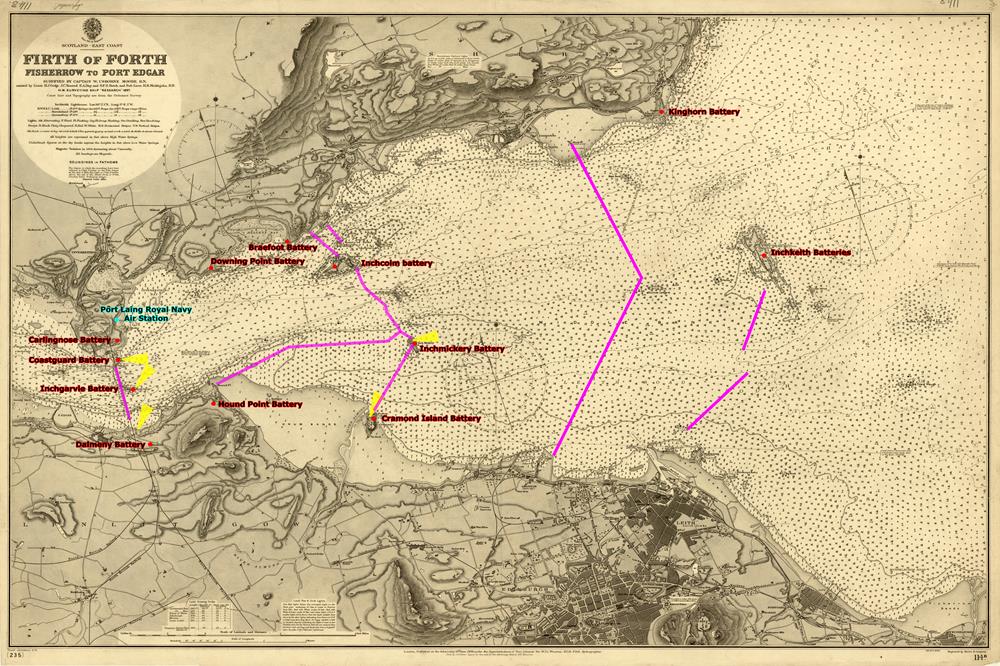Carlingnose Battery – Deeper defences in the Forth
| < The Guns in action | Δ Index | Carlingnose Battery today > |
The strength of the Royal Navy had kept Germany’s High Seas Fleet more or less confined to their base at Wilhelmshaven, but during 1914 and 1915 the High Seas Fleet conducted many sporadic raids in attempts to probe defences and lure elements of the Royal Navy into battle with larger forces.
The need for east coast naval bases to service the North Sea had been recognised at the end of the nineteenth century and plans for Rosyth Naval Base were announced in 1903. However the start of construction was delayed until 1909 with completion planned for 1916.
Meantime the battleships of the Royal Navy were based at the safe haven of Scapa Flow in Orkney, while Britain’s battle cruiser fleet of ten ships was moved from Cromarty to the Forth.
The 1908 proposals to provide gun batteries and anti-torpedo nets downstream of the Forth Bridge were revised at an October 1914 conference to discuss anti-submarine defences, and in late November, the Forth was closed to commercial traffic west of Oxcars for the security of the anchorage and the Forth Bridge. The closure also prevented neutral shipping from entering to gather intelligence.
A Middle Line of defences at the line of islands, Cramond, Inchmickery and Inchcolm, was put in place, to supplement the existing Inner Defences, at the bridge, and the Outer Defences, on Inchkeith and at Kinghorn.
 1914 coastal defences – a new middle line supplemented the outer line (batteries on Inchkeith and at Kinghorn) and the inner line at the Forth Bridge.
1914 coastal defences – a new middle line supplemented the outer line (batteries on Inchkeith and at Kinghorn) and the inner line at the Forth Bridge.
March 1916 – Completion of Rosyth Dockyard
Despite the outbreak of war, Rosyth Dockyard was completed to schedule – the works had been reorganized to bring some infrastructure into service as quickly as possible
May 1916 – the Battle of Jutland
Rosyth dockyard was completed just before the biggest naval battle of WWI. Germany’s Admiral Scheer tried to lure the cruisers of the Grand Fleet into an engagement with the full force of the High Seas Fleet at what became the Battle of Jutland on 31 May to 1 June 1916.
Both sides claimed victory. However although the British suffered higher losses, the Grand Fleet was able to resume action immediately, while the repairs to the High Seas Fleet put it out of commission for several months, and it remained effectively bottled up in port for the remainder of the war.
1916 – strengthening the defences in the Forth, and the closure of Carlingnose battery
One of the aftermaths of the Battle of Jutland was the desire to base the battleships of the Royal Navy’s Grand Fleet further south than Scapa Flow, so that they could engage the High Seas Fleet more rapidly.
It was decided that the entire Grand Fleet should be based on the Forth. This necessitated a further improvement in defence with a new Outer Line, and a reduction in armament on the Inner Line.
 The Forth defences by 1918 – new batteries at Pettycur and Leith created an Outer Line of batteries with Submarine nets between Elie and Fidra lying beyond
The Forth defences by 1918 – new batteries at Pettycur and Leith created an Outer Line of batteries with Submarine nets between Elie and Fidra lying beyond
The guns from Carlingnose Battery were removed and installed at the new battery at Pettycur in December 1916.
 Removal of the guns – from the Fort Record Book page 40
Removal of the guns – from the Fort Record Book page 40
| < The Guns in action | Δ Index | Carlingnose Battery today > |
top of page
